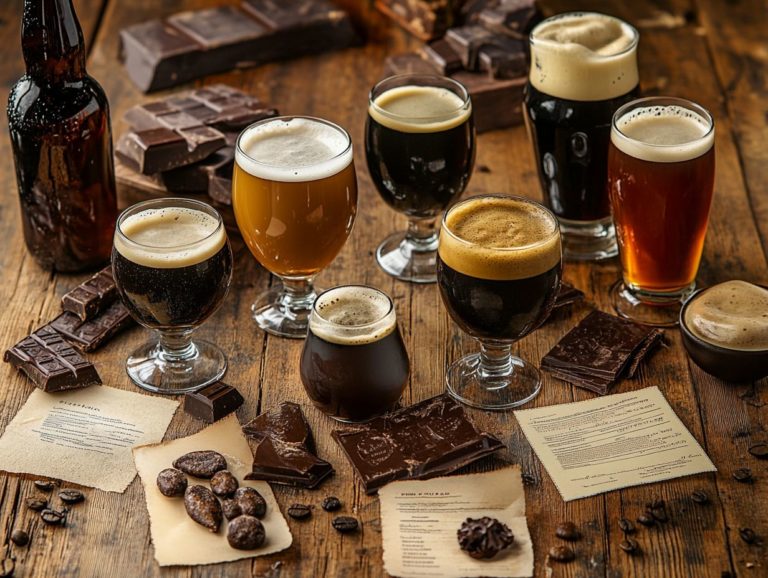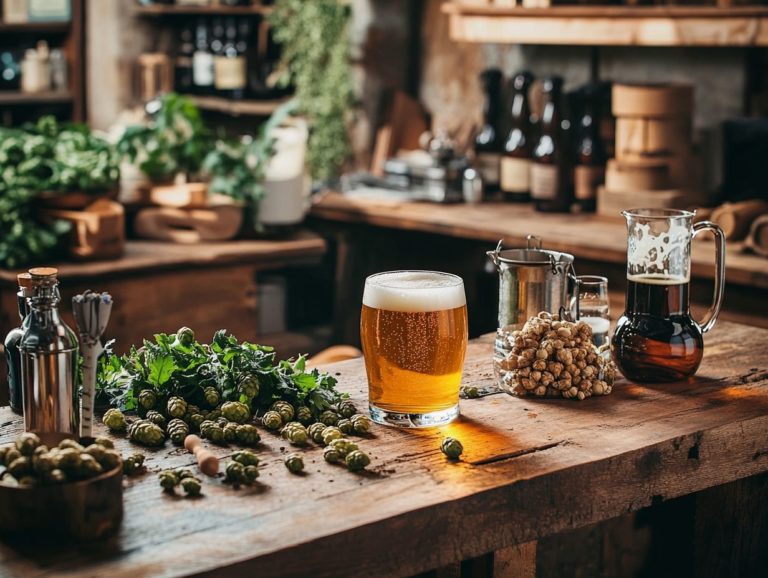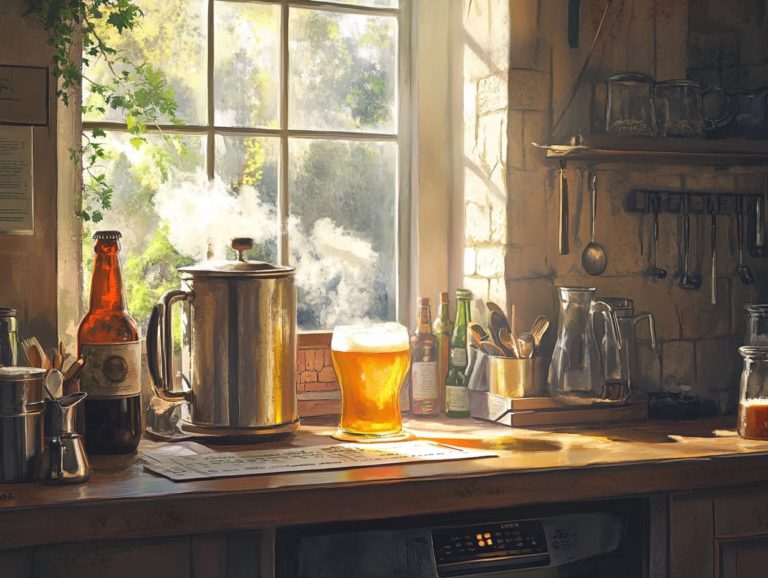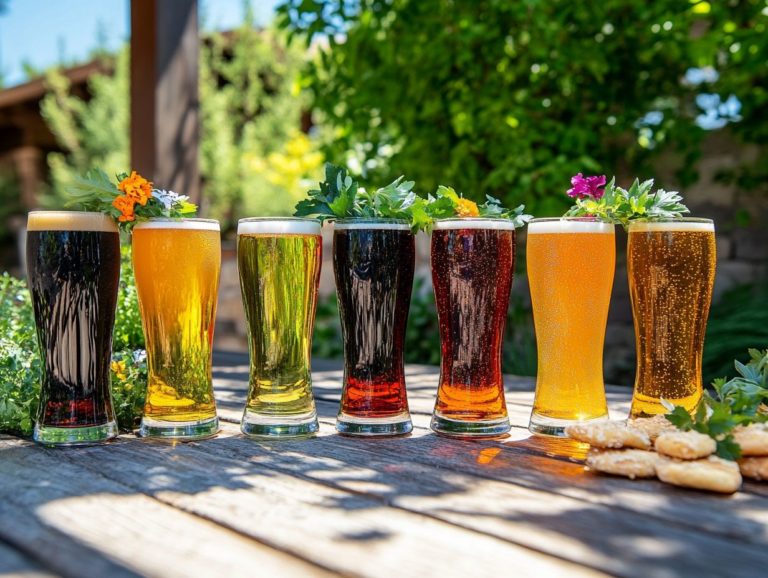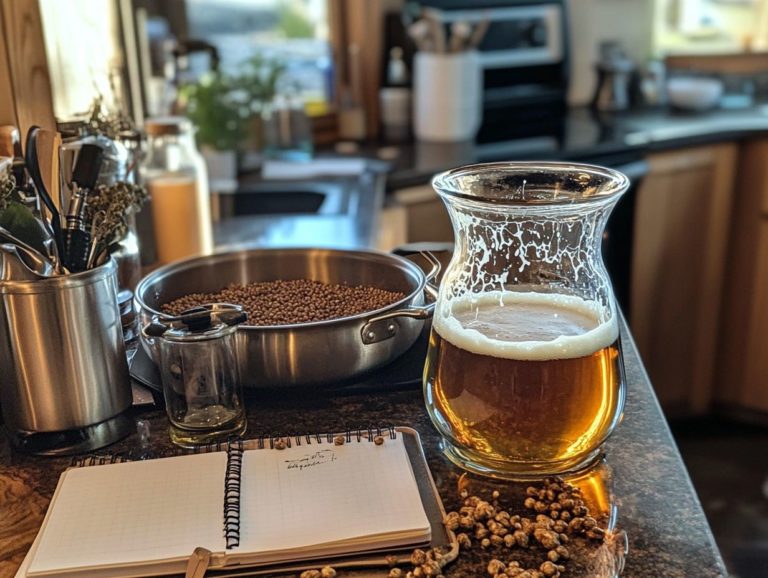Exploring Low Alcohol Beer Recipes
Contents
- Exploring Low Alcohol Beer: A Flavorful Alternative
- Key Takeaways:
- What Is Low Alcohol Beer?
- Why Brew Low Alcohol Beer?
- Can Low Alcohol Beer Still Taste Good?
- How Is Low Alcohol Beer Made?
- What Ingredients Are Used in Low Alcohol Beer?
- How Do These Ingredients Affect the Alcohol Content?
- What Are Some Popular Styles of Low Alcohol Beer?
- How to Adjust an Existing Beer Recipe to Make It Low Alcohol?
- What Are Some Delicious Low Alcohol Beer Recipes to Try?
- Frequently Asked Questions
- Exploring Low Alcohol Beer Recipes
Exploring Low Alcohol Beer: A Flavorful Alternative
In recent years, low alcohol beer has emerged as an invigorating alternative for those who wish to savor the essence of craft brews without the intoxicating effects. Breweries like Hairless Dog Brewing and UltraLow Brewing have pioneered this trend.
This article delves into the realm of low alcohol beer by unpacking its myriad benefits, exploring its diverse flavors, and shedding light on the brewing process. We’ll cover techniques like cold mashing and high-temperature mashing while highlighting the wide array of beer styles available.
Whether you’re a seasoned brewer or simply intrigued by crafting your own low alcohol recipes, you’ll find valuable insights and tips to help you create brews that are flavorful and enjoyable.
Key Takeaways:
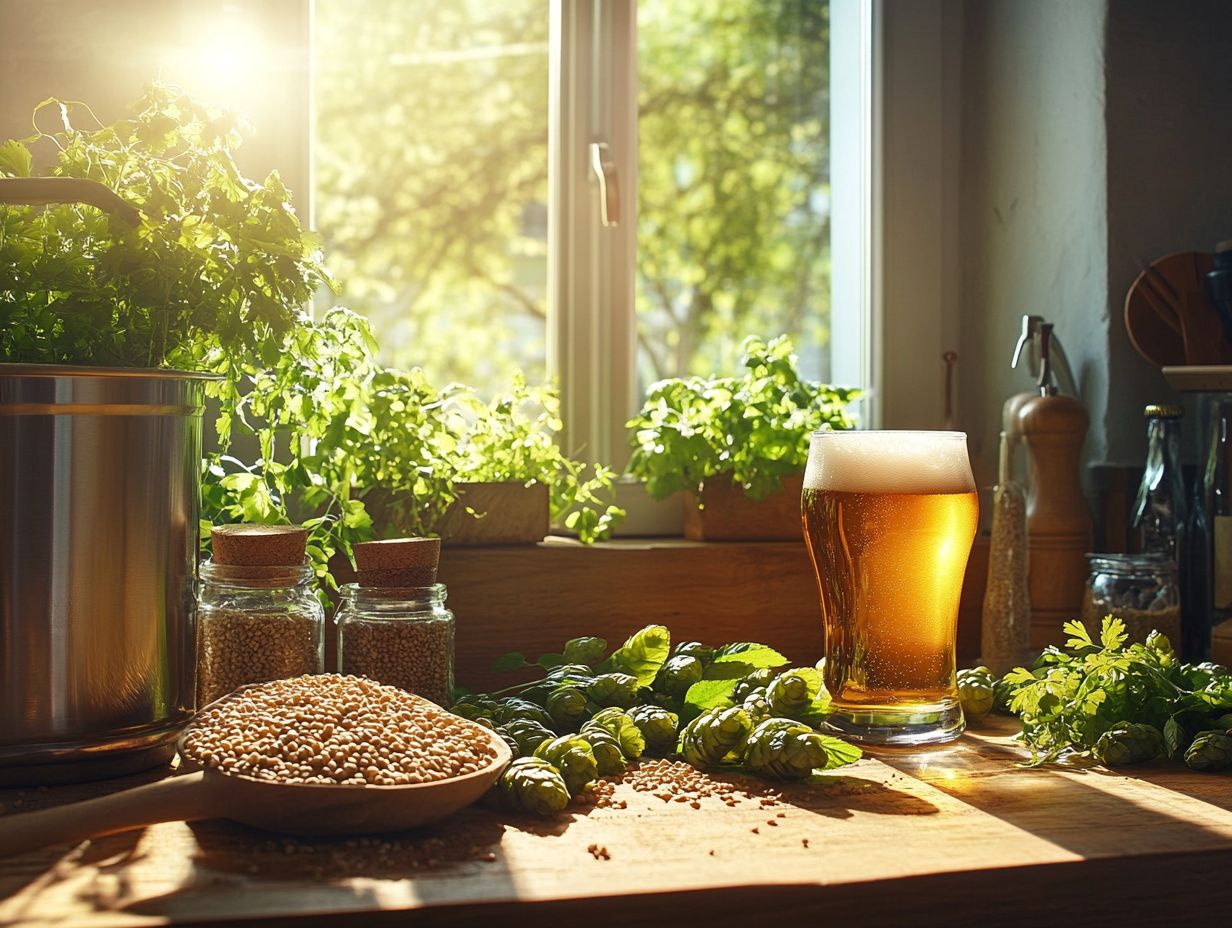
- Low alcohol beer is ideal for reducing alcohol intake or enjoying lighter options.
- These beers maintain flavor and enjoyment despite lower alcohol levels.
- Experimenting with ingredients can lead to unique and tasty low alcohol recipes.
What Is Low Alcohol Beer?
Low alcohol beer, commonly known as low ABV (Alcohol by Volume) beer, stands out as a unique category within the craft beer realm. Typically, it boasts an alcohol content of less than 3%. Breweries like American Solera have led the way in crafting these innovative options.
This style has captured the attention of discerning consumers who crave flavorful experiences without the repercussions associated with higher alcohol beverages. It allows for a more responsible enjoyment.
Crafted with innovative techniques and a meticulous selection of ingredients, low alcohol beer invites you to explore a diverse range of beer styles while keeping your sobriety and health in check. These beers often utilize hops for enhanced aromas. It’s an enticing choice for social gatherings and leisurely sipping, ensuring you can savor the moment without compromise.
Why Brew Low Alcohol Beer?
The art of brewing low alcohol beer has gained remarkable traction. This trend is thanks to its array of health benefits and the opportunity to create delightful beverages with lower alcohol content. Prominent breweries like UltraLow Brewing have been at the forefront of this movement, resonating with a diverse audience.
As the demand for low ABV options grows, breweries are diving into innovative brewing methods that preserve flavor while reducing the alcohol levels. Events like Brewcon showcase these advancements and highlight the latest brewing techniques.
This movement empowers brewers to craft distinctive flavor profiles, leading to a rich variety of beer styles that appeal to both casual drinkers and discerning craft beer enthusiasts, including creations by Craig Dillon and Ben Sanderson.
Ready to try brewing your own low alcohol beer? Explore local breweries that offer such options and enjoy the flavorful journey!
What Are the Benefits of Low Alcohol Beer?
Low alcohol beer presents a wealth of benefits, particularly its potential health advantages and its role in fostering responsible drinking practices. Brewing software like Brewfather can assist you in tracking malt ratios and yeast selection to achieve the perfect low ABV brew. This makes it an increasingly appealing choice for you as a thoughtful drinker.
With its lower alcohol content, low alcohol beer allows you to engage in a more moderate drinking experience, enabling you to relish social events without the typical downsides associated with higher alcohol by volume (ABV) beverages. Many of these beers boast rich flavors and aromas, ensuring that your taste buds remain satisfied. This has contributed to their rising popularity among both casual drinkers and craft beer aficionados.
Choosing low alcohol beer can also help you reduce your caloric intake, which is particularly beneficial if you’re aiming to manage your weight while still enjoying a refreshing drink. It permits you to savor the social aspects of drinking without the looming concern of excessive intoxication, promoting a culture of moderation and a more mindful approach to social consumption.
These brews also often contain more water than traditional beers, which leads to improved hydration levels.
With more breweries rapidly crafting expert low-alcohol options, you can enjoy a huge variety without compromising on quality in the name of health. This trend harmonizes well with the increasing movement toward conscious eating and drinking, allowing you to enjoy your beverages with both pleasure and peace of mind.
Can Low Alcohol Beer Still Taste Good?
Low alcohol beer can still deliver a remarkably satisfying taste, thanks to advanced brewing techniques and a careful selection of ingredients that enhance its flavor profile without the need for high alcohol content. Hops like Cascade and Magnum are often chosen for their aromatic qualities. Many brewers have truly honed the craft of balancing malt ratios and hop aromas, creating delicious low ABV beers that cater to your diverse palate, ensuring that you never have to compromise on quality for lower alcohol levels. Breweries often employ hops like Idaho 7 and yeast strains from Fermentis for ideal results.
Innovative brewing methods, like hop stands and cold mashing (which involves brewing at lower temperatures to extract flavor without increasing alcohol), have emerged to extract maximum flavor while keeping the alcohol content in check, demonstrating that great taste can indeed cohabit with lower alcohol levels. The secret often lies in the meticulous choice of hops; specific varieties are selected for their aromatic qualities, adding layers of complexity to the beer’s flavor without raising the alcohol content. Consider hops like Cryo Pop from Yakima Chief for your brewing process.
When you experiment with different malt ratios, you may uncover a richness that surprises even the most discerning palates. By utilizing creative adjuncts, such as fruits or spices, breweries further elevate the overall experience, making these low alcohol options not just enjoyable but truly memorable. You might also explore creating a Mocha Mild for a unique flavor profile.
As a result, the low alcohol beer category is continually evolving, appealing to a diverse range of beer enthusiasts eager to discover its refreshing offerings.
How Is Low Alcohol Beer Made?
Creating low alcohol beer is an art that involves a range of brewing techniques aimed at mastering the fermentation process and fine-tuning the malt bill to achieve that ideal low ABV, all while maintaining the intended flavors. Ingredients from suppliers like Briess can significantly impact the quality of your brew.
As you delve into this craft, you might find yourself experimenting with unique malt ratios, choosing the right yeast, and exploring innovative methods like high temperature mashing or cold mashing to elevate your brewing game. Using yeast strains like Zygosaccharomyces Lentus or Saccharomycodes Ludwigii from Fermentis can offer you more control during the fermentation process.
Additionally, selecting the perfect hops like Cryo Pop from Yakima Chief or Idaho 7 can enhance the hop aroma without pushing the alcohol content too high, resulting in a well-rounded beer that delights the palate and meets your preferences.
Discover the refreshing world of low alcohol beers today your taste buds will thank you!
What Are the Different Methods for Making Low Alcohol Beer?
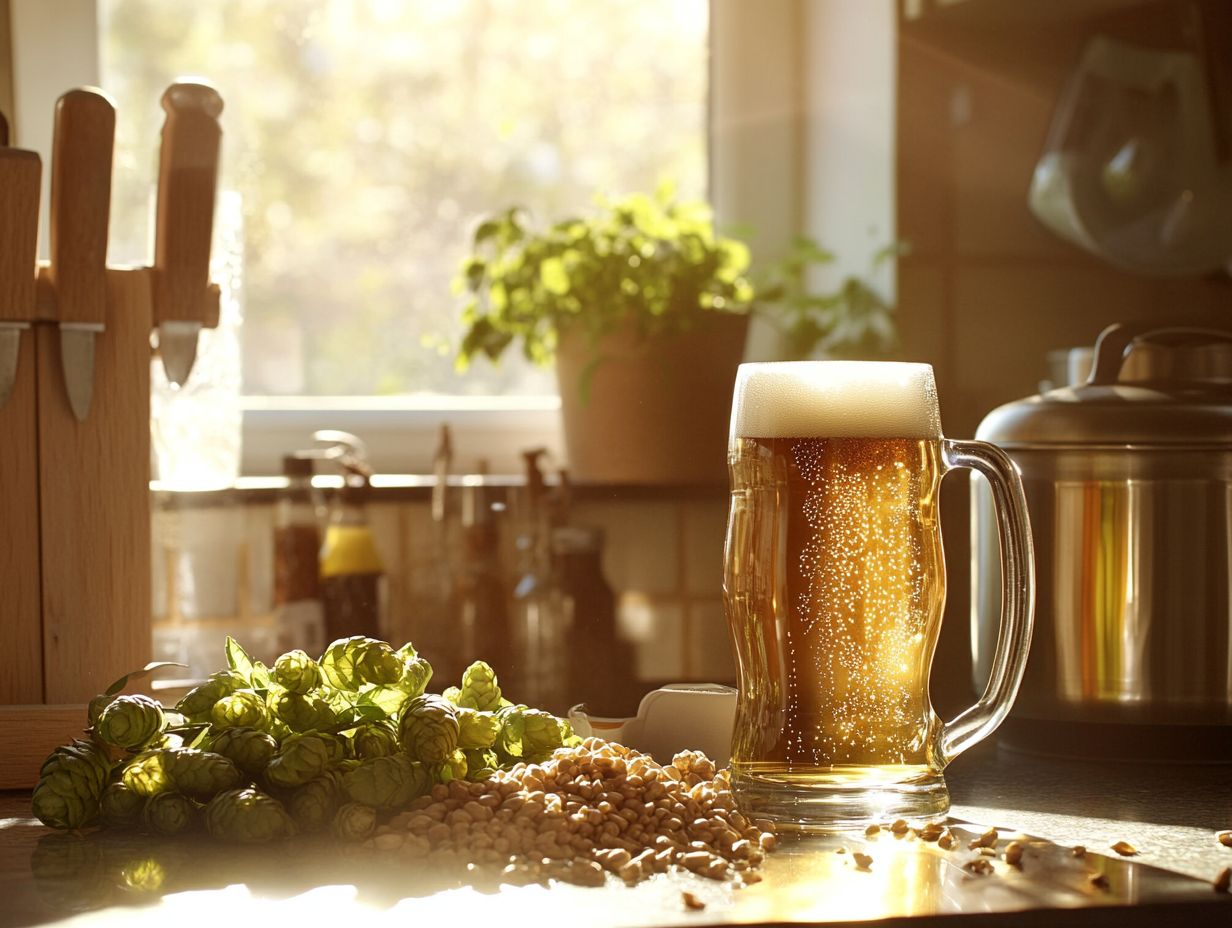
You ll discover a variety of brewing methods designed to craft low alcohol beer, each meticulously crafted to enhance flavor while keeping alcohol content in check. Techniques like cold mashing and high temperature mashing are key players in this process.
Cold mashing allows you to extract flavors from malt without generating excessive fermentable sugars. On the other hand, high temperature mashing offers a more efficient conversion of starches to sugars, which you can then skillfully manipulate during fermentation.
The choice of hops, such as Cascade and Magnum, is vital in achieving a robust flavor profile without raising the beer’s ABV. Choosing the right hops is also important for ensuring your beer is rich in aroma and flavor while maintaining a low ABV.
Methods like stopping fermentation early and specialized yeast strains play a significant role in fine-tuning the final alcohol content. Stopping fermentation early pauses the brewing process before all sugars turn into alcohol. This method keeps a hint of malt sweetness, enhancing the beer s flavor.
In terms of yeast, you can opt for strains that produce less alcohol during fermentation, striking a delicate balance in flavor profiles. Strains like Safale S-04 are popular choices among brewers. Ultimately, selecting hops like Citra or Saaz adds aromatic complexity, enriching the sensory experience while still honoring the low alcohol goal.
Crafting low alcohol beer is an exciting adventure where you harmonize various elements for a delicious outcome!
What Ingredients Are Used in Low Alcohol Beer?
The ingredients you choose for low alcohol beer are crucial in shaping the final flavor profile, aroma, and overall quality of your brew. It’s important to pay careful attention to malt ratios, hop selection, and yeast selection. Ingredients such as Munich and Vienna malts from Briess can help you achieve the desired characteristics.
By incorporating specialty malts like Munich and Vienna, you can achieve the desired characteristics while using lower quantities to keep the alcohol content minimal. Using brewing software like Brewcon can assist you in maintaining the ideal malt ratios.
Your ingredient choices are essential for crafting exceptional low alcohol beer. Additionally, selecting the right hops, such as Cryo Pop from Yakima Chief or Idaho 7, ensures your beer is rich in aroma and flavor while maintaining a low ABV.
How Do These Ingredients Affect the Alcohol Content?
The ingredients in low alcohol beer have a direct impact on your fermentation process and the resulting alcohol content, with malt ratios and yeast selection being particularly crucial factors. Consider using yeast strains like Zygosaccharomyces Lentus or Saccharomycodes Ludwigii for a controlled fermentation process.
By controlling the amount of fermentable sugars in your malt bill, you can determine the potential alcohol yield during fermentation. Thus, a lower malt ratio contributes to a lower final ABV. Breweries like NHC have mastered this balance to produce high-quality low alcohol beers.
The choice of yeast strains, such as Safale S-04 or Zygosaccharomyces Lentus from Fermentis, can influence how efficiently sugars are converted into alcohol. This makes your ingredient selection essential for achieving the right balance in low alcohol beer.
This interplay of ingredients not only affects fermentation efficiency but also shapes the beer’s flavor profile and mouthfeel. Higher malt ratios can lead to a richer taste, but if not managed correctly, they could push the ABV beyond desired levels.
Understanding this relationship gives you the power to craft low alcohol beer that delights the palate while remaining mindful of alcohol content. This creates a product that resonates with the growing market of health-conscious consumers.
What Are Some Popular Styles of Low Alcohol Beer?
Low alcohol beer presents an impressive assortment of styles designed to satisfy a variety of tastes!
You ll find popular choices such as session IPAs, rich low alcohol stouts like Mocha Mild, and crisp wheat beers.
Each of these styles is meticulously crafted to maintain a lower ABV (Alcohol by Volume) while still delivering bold flavors and distinctive characteristics that appeal to both craft beer aficionados and casual drinkers.
As the popularity of low alcohol beer grows, brewers are constantly innovating, creating new varieties that enrich the low ABV landscape. This ensures there s something delightful for everyone to enjoy.
What Are the Characteristics of Each Style?
Every style of low alcohol beer has unique characteristics that define its flavor, aroma, and overall experience, appealing to a wide range of discerning consumers. For example, session IPAs are celebrated for their hop-forward tropical aromas and crisp finish. In contrast, low alcohol stouts, such as Mocha Mild, provide rich, roasted malt flavors that maintain a smooth mouthfeel, even with their lower alcohol content.
When you understand these unique attributes, you can appreciate the nuances of low alcohol beer and choose options that align perfectly with your preferences.
The flavors found in low alcohol lagers present a delightful balance of delicate malt sweetness and subtle hop bitterness, often resulting in refreshingly enjoyable experiences ideal for social gatherings. Simultaneously, the emergence of low-alcohol wheat beers introduces bright citrus notes and playful spice elements that resonate with those in search of a lighter palate.
Each of these varieties not only caters to individual taste sensibilities but also invites those who typically favor higher alcohol content to explore the rich diversity of low alcohol options available on the market today.
How to Create Your Own Low Alcohol Beer Recipe?
Embarking on the journey of crafting your own low-alcohol beer recipe is both thrilling and rewarding, demanding thoughtful planning and attention to a variety of elements, such as the flavor profile you envision, the ingredients you choose, and the brewing software that will expertly steer you through each step.
By leveraging innovative brewing software like Brewfather, you can precisely calculate and adjust malt ratios, select the perfect hops, and fine-tune the fermentation process, all while aiming for a low ABV and a well-balanced, delectable final product.
Grasping these essential components will empower you to tailor your recipe to reflect your individual taste preferences and brewing aspirations.
What Are the Key Factors to Consider?
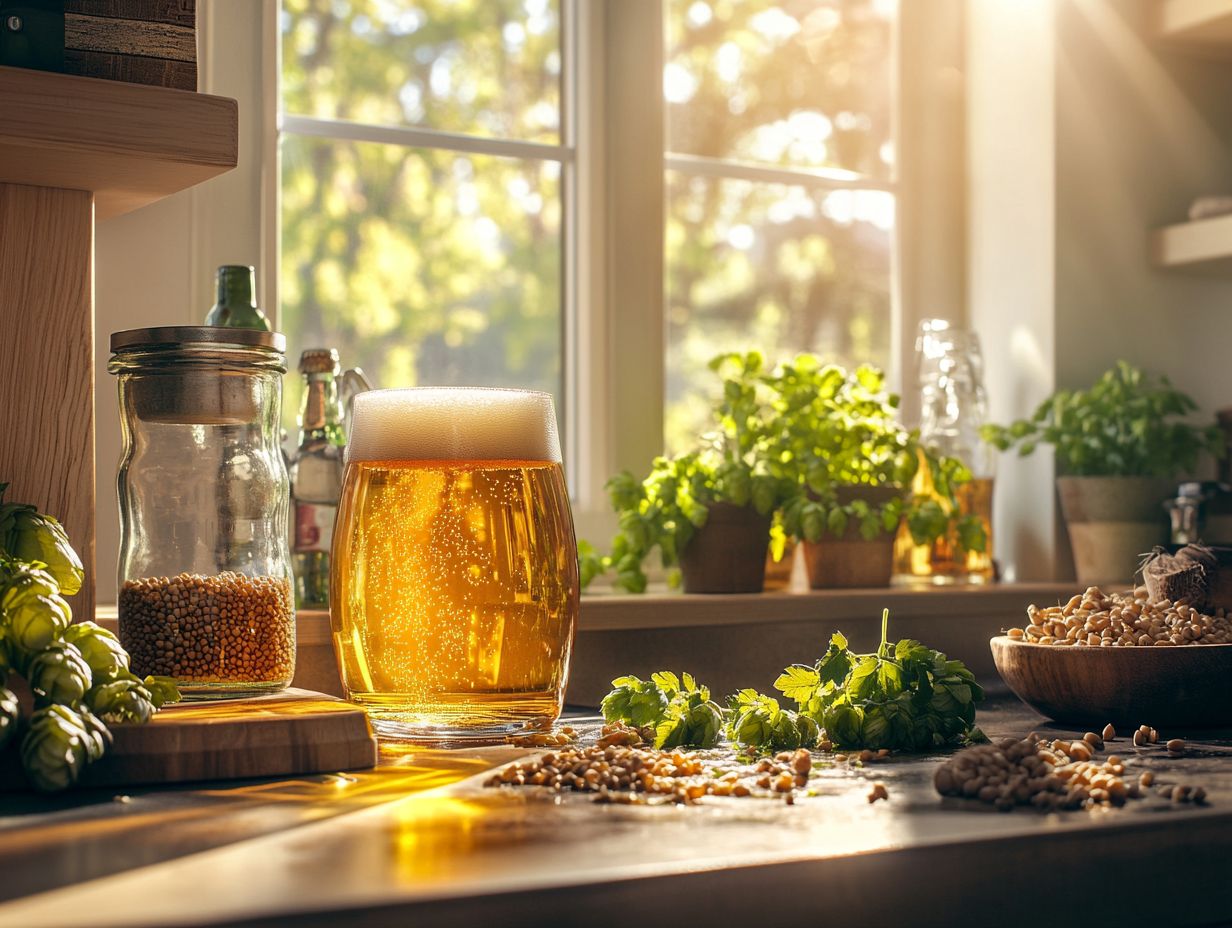
When you set out to craft a low alcohol beer recipe, there are several key factors you must consider to ensure a successful outcome. Pay attention to malt ratios, hop selection, and the brewing techniques you employ.
A lower malt ratio is essential for reducing alcoholic strength, while careful hop selection can enhance aroma and flavor without cranking up the ABV. Understanding brewing techniques, such as fermentation temperature and timing, will further contribute to achieving the profile and characteristics you desire in your low alcohol beer.
The choice of yeast strain is fundamental, as some yeasts naturally produce lower alcohol levels while still adding to the beer s body and mouthfeel. It s crucial to balance sweetness and bitterness through precise ingredient ratios, allowing you to create a pleasant final product that doesn t compromise on taste.
Experimenting with specialty grains can introduce unique flavors, enriching your overall brewing experience.
Regular tasting sessions during the brewing process will help you refine the recipe and ensure that the characteristics align with your expectations. With all these factors combined, you’re on your way to creating a well-rounded and enjoyable low alcohol beer.
Dive into the world of low alcohol beer and discover your new favorite style!
What Are Some Tips for Success?
To achieve exceptional results with your low-alcohol beer recipe, consider implementing a range of strategies focused on optimizing the brewing process and elevating the flavor profile. Start by ensuring you select the right yeast to facilitate a smooth fermentation process. Don t hesitate to experiment with various hop varieties to unveil unique aromas without increasing the alcohol content.
Maintaining temperature control during fermentation, along with rigorous sanitation practices, will play a crucial role in enhancing the overall quality and taste of your brew.
Utilizing specialty grains can add body and flavor without significantly impacting the alcohol percentage, making them an excellent choice for homebrewers like yourself. It s wise to monitor the fermentation closely; regular sampling will allow you to gauge progress and identify any potential issues early on. A hydrometer can be particularly beneficial for tracking changes in specific gravity.
Considering a shorter fermentation time might also help you retain the freshness that lighter beers are known for, preventing any undesirable flavors from creeping in. By employing these strategies, you ll be on your way to crafting a refreshing brew that captures the essence of low alcohol while delighting a variety of palates.
How to Adjust an Existing Beer Recipe to Make It Low Alcohol?
When you set out to adjust an existing beer recipe to craft a low-alcohol version, you ll discover exciting ways to modify your recipe. Several strategic modifications to both ingredients and brewing techniques are essential for achieving a balanced and enjoyable final product. Start by reducing the malt ratios to limit the fermentable sugars; this approach will lower the alcohol content without compromising the flavor integrity you cherish.
Think about tweaking the fermentation process by selecting yeast strains that naturally yield lower alcohol levels. This way, you can elegantly transform your favorite recipes into delightful low ABV offerings that still satisfy your palate.
What Changes Should Be Made to the Ingredients and Process?
To effectively adjust your existing recipe for low alcohol beer, you’ll need to make specific changes to both the ingredients and the brewing process. This way, you can achieve a successful transformation without sacrificing flavor. For example, reducing malt ratios is crucial to limit fermentable sugars. Simultaneously, carefully selecting hops can enhance flavor and aroma without significantly increasing the ABV.
It s also essential to adjust the brewing process, including fermentation temperature and yeast selection, to create a balanced low-alcohol beer that retains the characteristics of your original recipe.
In terms of malt ratios, consider using a blend of base and specialty malts. This approach maintains complexity while keeping the overall sugar content lower. On the flip side, opting for late hop additions or dry hopping can elevate the beer’s aromatic profile, ensuring that it remains enjoyable despite a lower alcohol content.
Selecting yeast strains with lower sugar-conversion abilities will help you control the final gravity and contribute to a smooth mouthfeel, providing a balanced flavor experience that honors the essence of traditional brewing.
By thoughtfully implementing these adjustments, you can craft engaging low-alcohol variations that will appeal to a wider audience.
What Are Some Delicious Low Alcohol Beer Recipes to Try?
Exploring delicious low-alcohol beer recipes opens up a world of flavors and styles, inviting you to enjoy brewing experiences that align perfectly with your preference for lower ABV options.
Among the favorites are session IPAs, celebrated for their tropical aromas and refreshing qualities, alongside unique low-alcohol stouts like Mocha Mild, which delivers rich, roasted flavors without the weight typically associated with higher alcohol drinks.
Each recipe presents a chance for you to experiment and delve into the delightful realm of low-alcohol beer, all while highlighting the artistry of craft brewing. So why wait? Grab your brewing equipment and start experimenting today!
Frequently Asked Questions
What is low alcohol beer?
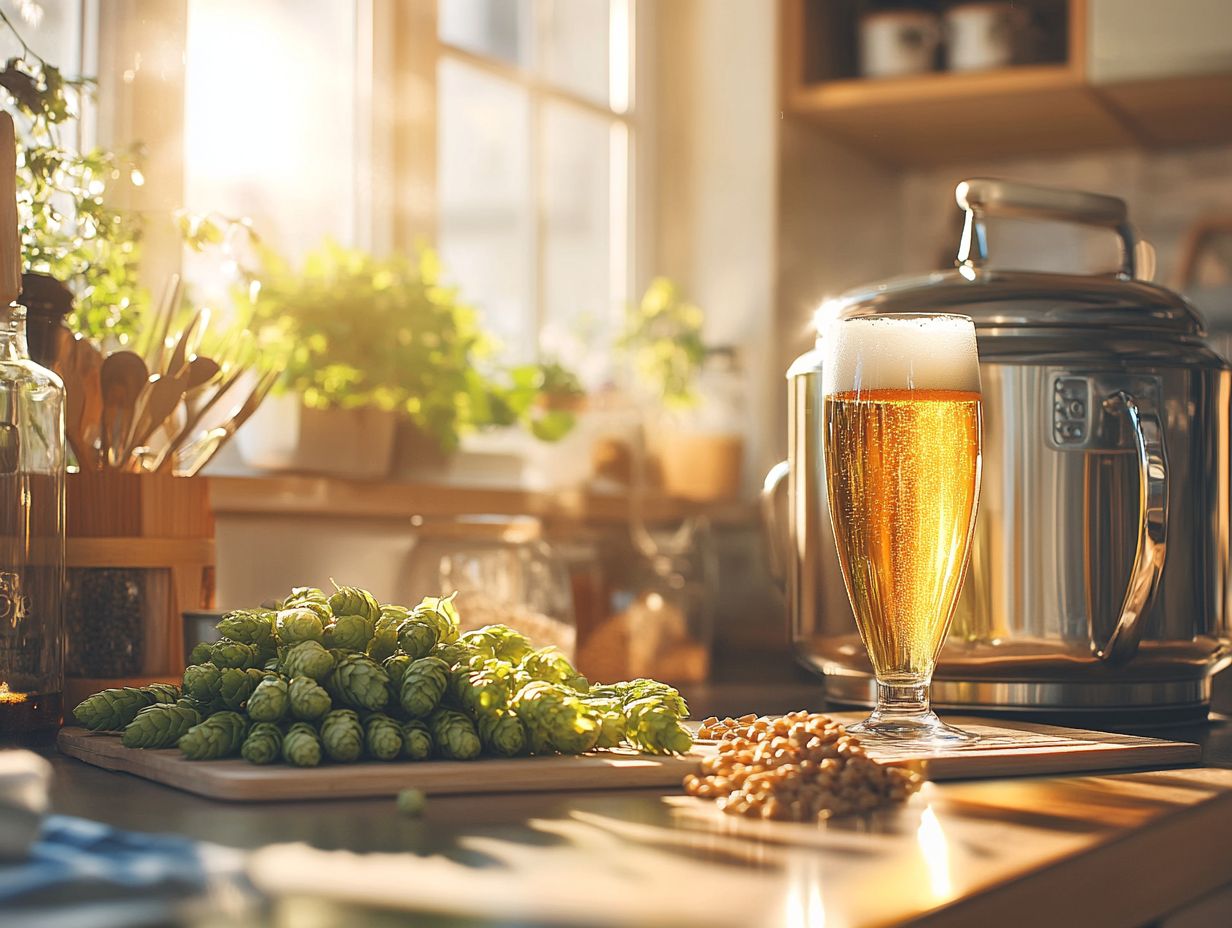
Low alcohol beer refers to beer with a lower percentage of alcohol by volume (ABV) compared to traditional beers. This means it contains less alcohol and has a milder taste.
Exploring Low Alcohol Beer Recipes
Why would someone want to explore low alcohol beer recipes?
There are several reasons someone might explore low alcohol beer recipes. Brands like Hairless Dog Brewing and UltraLow Brewing are gaining popularity for their unique brewing methods.
Are there any health benefits to drinking low alcohol beer?
Discover the health benefits of low alcohol beer, which can be lower in calories and help you enjoy your favorite flavors with less guilt! However, remember to enjoy low alcohol beer in moderation to reap its benefits without compromising your health.
Are there specific ingredients used in low alcohol beer recipes?
Common ingredients in low alcohol beer recipes include malted grains, hops, water, and yeast. Alternative ingredients, like non-fermentable sugars and specialized yeasts, can also be used to achieve a lower alcohol by volume (ABV).
Adding hops like Idaho 7, Cascade, and Magnum can enhance the hop profile. Using malt varieties like Munich, Vienna, and Briess can add depth to the malt flavor.
Breweries like American Solera often experiment with different malt ratios and hop selections to create unique flavor profiles.
Can low alcohol beer still have a good taste?
Yes, low alcohol beer can still have a good taste. While the lower ABV may result in a slightly weaker flavor, there are many ways to enhance the taste through different ingredients and brewing techniques.
Employing techniques like hop stand and high temperature mashing can develop a richer flavor profile. Notable beers like Mocha Mild and contributions from brewers like Craig Dillon and Ben Sanderson have shown that low alcohol beers can be flavorful and satisfying.
For instance, Cryo Pop Hops and Yakima Chief products are popular choices for enhancing hop aroma and tropical aromas.
Are there any tips for brewing successful low alcohol beer?
Some tips for brewing successful low alcohol beer include using a reliable recipe and paying attention to the fermentation process. Experimenting with different ingredients can help achieve desired flavors.
It is also important to measure and control the alcohol levels throughout the brewing process. Utilizing brewing software like Brewfather can help accurately track your brewing parameters.
Additionally, considering the malt bill and yeast selection, like Safale S-04, can significantly impact the beer’s final flavor profile.

